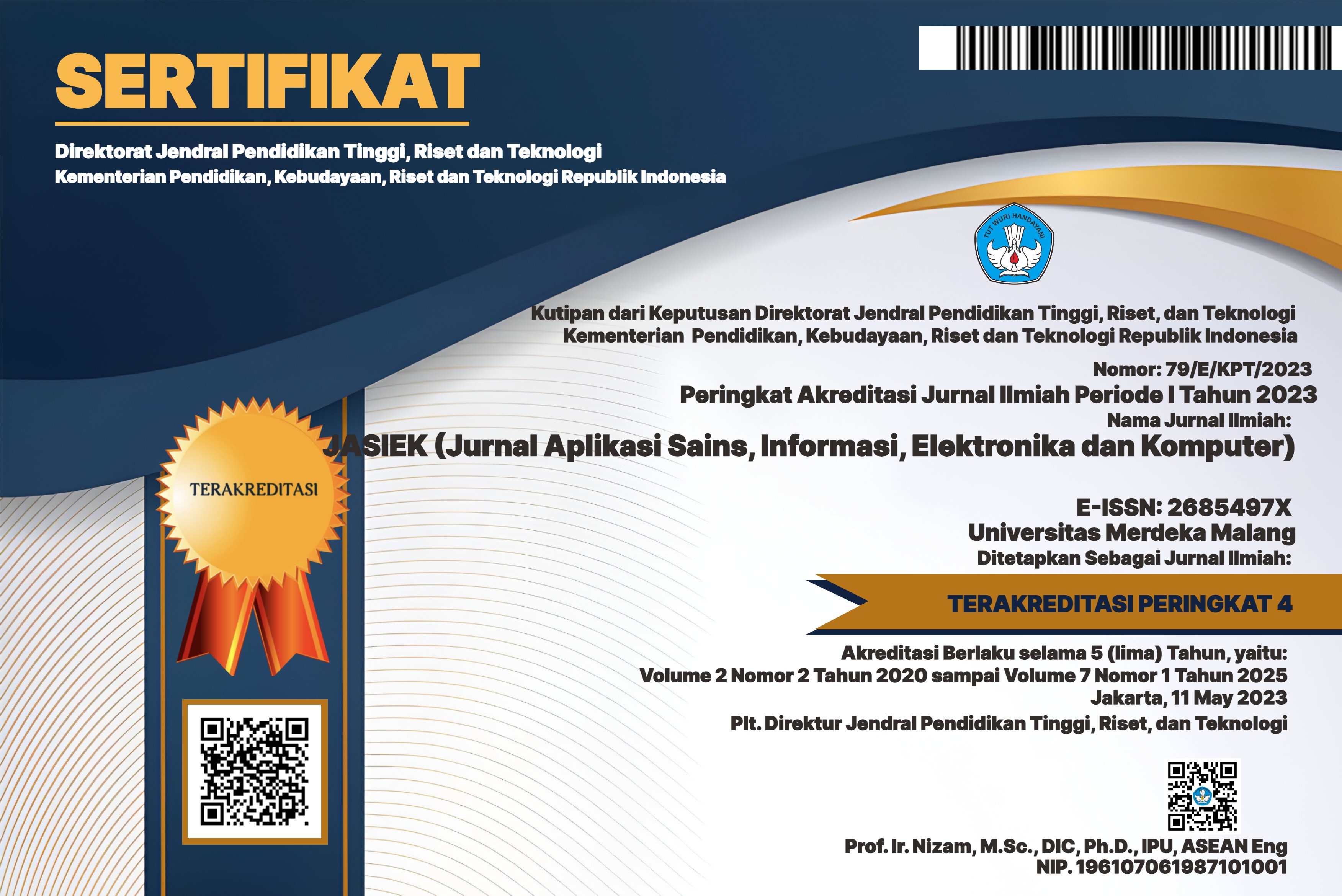Implementasi Modified K-Nearest Neighbor (MKNN) untuk Deteksi Penyakit Anemia
DOI:
https://doi.org/10.26905/jasiek.v7i1.13425Keywords:
Anemia, Classification , Early Diagnosis , Machine Learning , MKNNAbstract
Anemia is a condition where the hemoglobin level in the human body drops below the normal threshold. It can cause several negative effects, such as delayed psychomotor development, a higher risk of infectious diseases, and in women, the possibility of premature birth. Therefore, early detection of anemia is essential to speed up treatment and recovery. One method that can support the diagnostic process is machine learning, particularly the Modified K-Nearest Neighbor (MKNN) algorithm. MKNN is an improved of standard KNN, incorporating additional steps such as validity calculation and weighted voting, which are not present in the original version. In this study, MKNN was applied to detect anemia and achieved an accuracy of 84% using a 75:25 train-test data split and k=5. The dataset was collected from Jemursari Hospital in Surabaya, consisting of 100 patient records. These records were used to evaluate the performance of the MKNN algorithm in anemia detection.
Downloads
References
[1] Cholissodin, I., Marvela Evanita, F., Tedjasulaksana, J. J., Wahyuditomo, K. W., & Korespondensi, P. (2021). Klasifikasi tingkat laju data covid-19 untuk mitigasi penyebaran menggunakan metode modified k-nearest neighbor (mknn). 8(3). https://doi.org/10.25126/jtiik.2021834400
[2] Sari, A. P., Suzuki, H., Kitajima, T., Yasuno, T., Prasetya, D. A., & Arifuddin, R. (2022). Short‐Term Wind Speed and Direction Forecasting by 3DCNN and Deep Convolutional LSTM. IEEJ Transactions on Electrical and Electronic Engineering, 17(11), 1620-1628.
[3] Spezia, J., Carvalho, L. F. da S., Camargo-Filho, M. F. de A., Furman, A. E., Utiyama, S. R. da R., & Henneberg, R. (2018). Prevalence of anemia in schools of the metropolitan region of Curitiba, Brazil. Hematology, Transfusion and Cell Therapy, 40(2), 151–155. https://doi.org/10.1016/j.htct.2017.11.007
[4] Gumilang, L., Nurlaelasari, D., Dhamayanti, M., Tina Dewi Judistiani, R., Martini, N., Yogi Pramatirta, A., & Anak Rumah Sakit Umum Pusat Hasan Sadikin Bandung Fakultas Kedokteran, K. (2021). Gambaran Faktor Risiko Kejadian Anemia Pada Balita. Jurnal Kebidanan Malahayati), 7(4), 681–687. https://doi.org/10.33024
[5] Levy, T. S., de la Cruz Góngora, V., & Villalpando, S. (2015). Anemia: Causes and Prevalence. In Encyclopedia of Food and Health (pp. 156–163). Elsevier Inc. https://doi.org/10.1016/B978-0-12-384947-2.00029-5
[6] Who. (2023, May 12). WHO calls for accelerated action to reduce anaemia, https://www.who.int/news/item/12-05-2023-who-calls-for-accelerated-action-to-reduce-anaemia>
[7] Kemenkes. (2022, November 16). Remaja Bebas Anemia: Konsentrasi Belajar Meningkat, Bebas Prestasi. https://ayosehat.kemkes.go.id/remaja-bebas-anemia-konsentrasi-belajar-meningkat-bebas-prestasi>
[8] Hermawan, A., & Avianto, D. (2021). Prediksi Curah Hujan Wilayah Provinsi Yogyakarta dengan Algoritma Neural Network. JASIEK (Jurnal Aplikasi Sains, Informasi, Elektronika dan Komputer), 3(1), 47-54.
[9] Sivakumar, M., Parthasarathy, S., & Padmapriya, T. (2024). Trade-off between training and testing ratio in machine learning for medical image processing. PeerJ Computer Science, 10, e2245.
[10] Rizky, J. L., & Putra, Z. P. Analisis Perbandingan Algoritma Pembelajaran Mesin untuk Meningkatkan Akurasi dan Klasifikasi Tumor Otak. IJAI (Indonesian Journal of Applied Informatics), 9(1), 31-44.
[11] Jatoi, S., Aamir Panhwar, M., Sulleman Memon, M., Ahmed Baloch, J., & Saddar, S. (2018). Mining Complete Blood Count Reports For Disease Discovery. In IJCSNS International Journal of Computer Science and Network Security (Vol. 18, Issue 1).
[12] Ulva, T., Stikes, K., & Kendal, M. (2022). Peran Edukasi Gizi Dalam Pencegahan Anemia Pada Remaja Di Indonesia: Literature Review. 4(1).
[13] Cappellini, M. D., Musallam, K. M., & Taher, A. T. (2020). Iron deficiency anaemia revisited. Journal of internal medicine, 287(2), 153-170.
[14] Buda, M., Maki, A., & Mazurowski, M. A. (2018). A systematic study of the class imbalance problem in convolutional neural networks. Neural networks, 106, 249-259.
[15] Li, W., Zhong, K., Wang, J., & Chen, D. (2021). A dynamic algorithm based on cohesive entropy for influence maximization in social networks. Expert Systems with Applications, 169, 114207.
Downloads
Published
Issue
Section
License
Copyright (c) 2025 JASIEK (Jurnal Aplikasi Sains, Informasi, Elektronika dan Komputer)

This work is licensed under a Creative Commons Attribution-NonCommercial-ShareAlike 4.0 International License.
Authors who publish with this journal agree to the following terms:
The journal allow the authors to hold the copyright without restrictions and allow the authors to retain publishing rights without restrictions.
Authors retain copyright and grant the journal right of first publication with the work simultaneously licensed under a Creative Commons Attribution-ShareAlike 4.0 International License that allows others to share the work with an acknowledgement of the work's authorship and initial publication in this journal.
Authors are able to enter into separate, additional contractual arrangements for the non-exclusive distribution of the journal's published version of the work (e.g., post it to an institutional repository or publish it in a book), with an acknowledgement of its initial publication in this journal.
Authors are permitted and encouraged to post their work online (e.g., in institutional repositories or on their website) prior to and during the submission process, as it can lead to productive exchanges, as well as earlier and greater citation of published work (See The Effect of Open Access).

This work is licensed under a Creative Commons Attribution-ShareAlike 4.0 International License.










